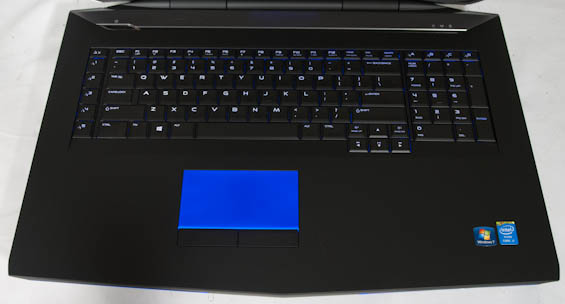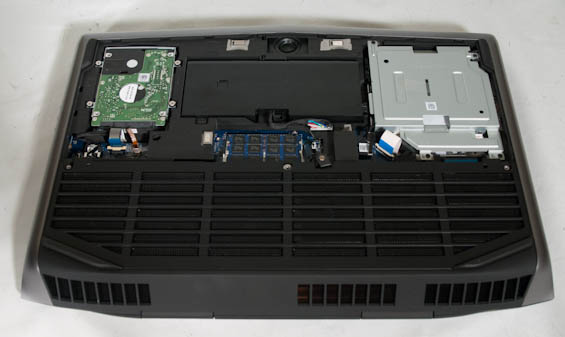Alienware 18 Gaming Notebook Review
by Dustin Sklavos on September 16, 2013 12:00 PM ESTIf you read the review of the Alienware 17, this part is going to be pretty familiar to you. While the original Alienware M18x looked like they took the M17x R3's chassis design and just stretched it out, the 18 looks like a more proportional super-size of the 17. It's really about as attractive as an 18.4" behemoth is going to get, but users who aren't interested in a 12 pound notebook need not apply.
As with the Alienware 17, we have an aluminum lid with accent lighting, bevelled body with lit trim, and soft touch plastic used on the majority of the touchable surfaces. I know a lot of you don't like how Alienware notebooks look, but I really have to stress that photos don't do them justice. I wasn't a fan either until I actually laid hands on and spent time with the M17x R3, and the same was true of the 17 and now the 18. Once you sit there and use the notebook, you start to dig it. The configurable lighting can be as ostentatious or mundane as you like; I configured mine magenta simply because you never see anyone with a magenta-backlit notebook.

With all that said, my reservations about the Alienware 17's keyboard and touchpad continue to apply to the 18. I'm not a fan of the revised keyboard layout as the programmable keys above the number pad make virtually no sense, and I never liked the column of programmable keys next to the primary keyboard on the original M18x. If you navigate a keyboard by touch, you're used to feeling for the Control key by finding the bottom left of the keyboard. On this keyboard, you'll wind up hitting the 5th macro key instead of Control. If Alienware is going to continue to include these keys, they need to adjust their position so that they're more distinct from the rest of the keyboard.
I'm also still not a fan of the backlit touchpad and vastly prefer the lit trim on the old model. Backlighting the touchpad just creates this giant block of light whenever you use it, and while you can certainly disable it, you can't disable paying for it.

The interior is also a lot less user friendly than it used to be. The primary panel only reveals the drive bay and two DIMM slots. Thankfully, one of the major benefits of Dell owning Alienware is that detailed service manuals for end users continue to be readily available for Alienware notebooks.
I like how the Alienware 18 looks a lot more than I did the M18x and M18x R2, even if it feels even bulkier than those beasts. As far as I'm concerned, something like this is basically an all-in-one in a different shape and without the touchscreen. I'm still more bullish on the Alienware 17 for the majority of users, but at least the 18 is more justifiable than its predecessors were.


_thumb.jpg)
_thumb.jpg)
_thumb.jpg)
_thumb.jpg)
_thumb.jpg)
_thumb.jpg)








60 Comments
View All Comments
DanNeely - Tuesday, September 17, 2013 - link
Considering that Dell didn't have the 780m's in the review model available to order when the article was published due to a supply shortage any argument that begins "Dell ought to be able to source X" is clearly suspect.Notmyusualid - Monday, September 16, 2013 - link
Yes, not far off pal.2133MHz is availabe in sodimm, but runs at a lazy CAS12. That I can do with my 1866MHz sodimm, but I keep it at 1866MHz, and CAS9. I do however have to run it at 1.6V.
Here:
Manufacturer Kingston Technology Company
Manufacturer Part Number KHX21S12P1K2/8
Manufacturer Website Address http://www.kingston.com
Brand Name Kingston
Product Line HyperX PnP
Product Name 8GB 2133MHz DDR3 Non-ECC CL12 SODIMM (Kit of 2) HyperX Plug n Play
Product Type RAM Module
madmilk - Monday, September 16, 2013 - link
DDR3-1600 is fine. The big bandwidth hog is the iGPU, but no one cares about a couple extra percent in iGPU performance on a laptop with discrete graphics.ShieTar - Tuesday, September 17, 2013 - link
I read some German magazines who have the tendency to run gaming benchmarks every year or so, and its been a long time since you could get any relevant performance boost out of higher than normal DDR speeds with an INTEL CPU. All you get from 2400 vs 1600 is about a 2% to 4% boost in performance, if you're lucky.As far as what kind of memory you will need in 5 years, that is total guessing on your part. Game developers will use what is widely available, and with the new generation of gaming consoles getting a big increase in memory, and PC systems starting to look at 8GB at the low-end configuration, it is entirely possible that a game released in 2015, 2016 will happily use up 16GB of memory when set to high settings. Nevermind the fact that a lot of people have plenty of background tasks running on their machines when gaming. Personally I am happy with 16GB right now, but I would not mind getting 32GB on a laptop which I would plan to use for 3-5 years.
DanNeely - Tuesday, September 17, 2013 - link
While the amount is debatable, I'm almost certain the type answer for 5years from now will be DDR4 for anything new. It's expected to finally launch with Haswell-EX next year; with Skylake bringing to the mainstream in 2015/16.Having recently bumped against 12GB in my aging LGA1366 box, I'm intending to go directly to 32GB in my Haswell system and hope that continued CPU stagnation will let me just buy new GPUs until 2017 or 18.
Pathfindercod - Tuesday, September 17, 2013 - link
the low voltage 1.35v ram is the ONLY ram the mobile haswell chipset supports, they had no option.Pathfindercod - Tuesday, September 17, 2013 - link
Glossy is the only option available from lcd manufacturers in the 18.4 inch size.prophet001 - Monday, September 16, 2013 - link
Why do they put all these weak resolution screens on notebooks nowadays.brucek2 - Monday, September 16, 2013 - link
a) on a gaming machine like this, you can't exceed the resolution your GPUs can drive. So 1600p is out.b) on mass market machines sold at retail, consumers will in part base their decision on how the screen looks to them. The default approach of Windows and its applications to a high resolution screen in a tiny amount of space is just to make everything look really, really tiny. So the customer moves on to the next unit.
c) Cost. Always a factor. Even if just to draw the customer in to a discussion that will soon result in upselling to a better display, you need that base model with the lowest possible cost to even get started.
boeush - Monday, September 16, 2013 - link
a) You can always scale down the resolution while playing games. However, the resolution would really come in handy when surfing the web, playing back UHD movies (which will start showing up over the next few years), working with documents, etc.Why is it that people insist on $4,000 super-beefy notebooks being used *only* to play games? If you're going to spend that much money, wouldn't you want to maximize the utility of what you get??
b) This is definitely **not** a mass market machine! It is a highly-specialized, niche product for hard-core enthusiasts with a lot of money in their pocket.
c) Are you serious? This is Alienware we're talking about. Cost is not a factor here, since it's a foregone conclusion that you'll pay way more just for the brand alone, relative to comparable designs from any other company...